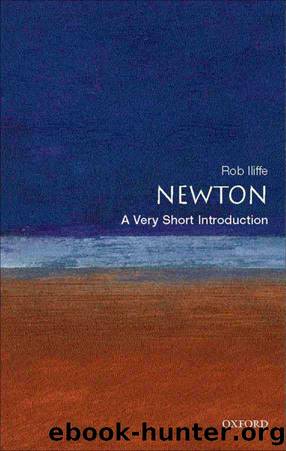Newton: A Very Short Introduction (Very Short Introductions) by Rob Iliffe

Author:Rob Iliffe [Iliffe, Rob]
Language: eng
Format: epub, mobi
Tags: History, Europe, Great Britain, Science & Math, History & Philosophy, Mathematics, Physics
Amazon: B003N2P412
Publisher: OUP Oxford
Published: 2007-01-25T00:00:00+00:00
Light and aether acted upon each other, he continued, aether refracting light, and light acting on aether to make heat. Light could also cause aether to vibrate, sending vibrations cascading through a larger body in the same way that the beating of a pair of drums could stimulate the air to vibrate. By analogy with the way that vibrating air gave rise to sound, the experience of various colours could be caused by vibrations set up in the capillamenta of the optic nerve. The strongest vibrations would cause the most intense colours, and Newton even proposed that light could be analysed according to the way that sound was ‘graduated’ into tones. Indeed, it was in this paper that Newton first publicly suggested (on the basis of lines drawn by a friend) that the spectrum be divided up into seven colours, again on analogy with the octave. Finally he attempted to explain how concentric bands appeared in thin plates, and also how diffraction occurred. The latter had caused a disagreement at the Royal Society meeting in spring 1675 where Hooke had raised the topic, Newton asserting that it was merely a form of refraction, and Hooke affirming that, if so, it was a novel sort. In the ‘Hypothesis’, however, Newton now pointed out that he had read that, long before Hooke, Grimaldi had performed some diffraction experiments.
Download
Newton: A Very Short Introduction (Very Short Introductions) by Rob Iliffe.mobi
This site does not store any files on its server. We only index and link to content provided by other sites. Please contact the content providers to delete copyright contents if any and email us, we'll remove relevant links or contents immediately.
The Complete Stick Figure Physics Tutorials by Allen Sarah(7334)
Secrets of Antigravity Propulsion: Tesla, UFOs, and Classified Aerospace Technology by Ph.D. Paul A. Laviolette(5330)
Thing Explainer by Randall Munroe(3905)
The River of Consciousness by Oliver Sacks(3571)
The Order of Time by Carlo Rovelli(3162)
How To by Randall Munroe(3074)
A Brief History of Time by Stephen Hawking(2990)
I Live in the Future & Here's How It Works by Nick Bilton(2957)
What If?: Serious Scientific Answers to Absurd Hypothetical Questions by Randall Munroe(2667)
The Great Unknown by Marcus du Sautoy(2661)
Midnight in Chernobyl by Adam Higginbotham(2515)
Blockchain: Ultimate Step By Step Guide To Understanding Blockchain Technology, Bitcoin Creation, and the future of Money (Novice to Expert) by Keizer Söze(2465)
Networks: An Introduction by Newman Mark(2382)
The Meaning of it All by Richard Feynman(2317)
Easy Electronics by Charles Platt(2307)
The Tao of Physics by Fritjof Capra(2247)
Midnight in Chernobyl: The Untold Story of the World's Greatest Nuclear Disaster by Adam Higginbotham(2195)
When by Daniel H Pink(2098)
Introducing Relativity by Bruce Bassett(2097)
